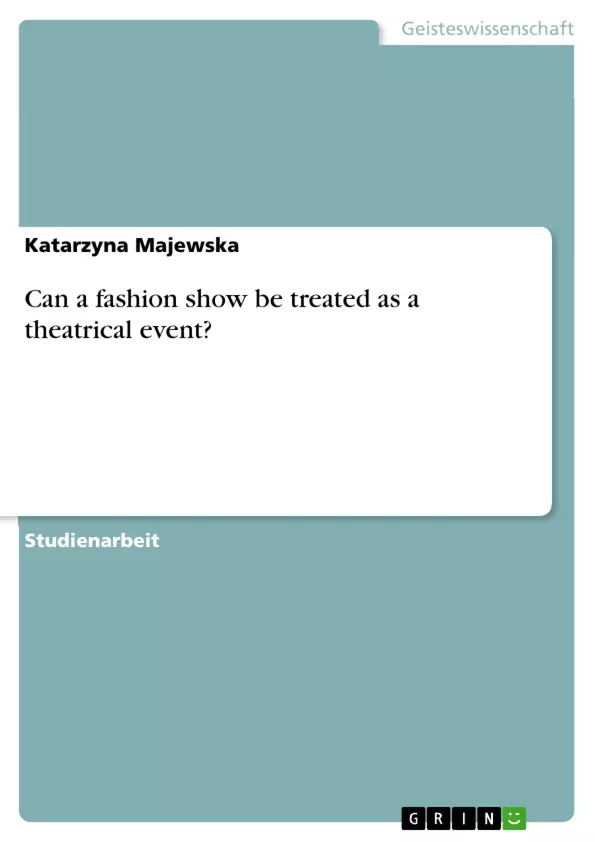My concern in this work is an analysis of the history and theory of fashion in terms of the idea of a spectacular parade (fashion show). These issues are grouped under three headings. Chapter 1 deals with fashion theory and its historical background. I start off with explaining what the fashion is. I proceed with the historical background of the fashion and notice its great influence on contemporary visual culture e.g. by organizing fashion shows as kind of carnival. I will explore such phenomena as performance, spectacle and theatre in relation to fashion show, considering early mannequins from the mid-nineteenth century in Paris "Haut Couture" and New York of the early years of the twentieth century. I will search for art elements in contemporary fashion show looking at how the fashion show as Alexander McQueen and John Galliano displays take on the appearance of the spectacle. After all, my work looks at the way which fashion mutated in the late twentieth-century spectacle.
The central question of my work is whether fashion can be treated as theatrical, eventually artistic event. Many people consider fashion as much as an art as painting or sculpture for example or at least consider the fashion design to be an applied art. There is, then, debate as to whether design of clothing, is an art or a design activity. Do the models wear dresses or costumes like the actors in the theatre? Is that right that fashion design enjoy today a lower status than any of the so-called fine arts? Although my purpose is not an attempt to conquer fashion catwalk (show) under the flag of theory, but rather an attempt to create a place for dialogue, exploration and questioning.
Inhaltsverzeichnis
- Introduction
- 1 What fashion is?
- 2 What fashion is not?
- 3 History of modeling
- 3.2 Recycling of history in postmodern fashion.
- 3.3 Galliano's Shows in the 1990s - recalling Paris of the nineteenth century..
- 4 The definition of performance
- 4.1 Performance- theatre- fashion show relations
- 5 Fashion as communication .......
- 5.1 Ubiquity of spectacles in current media culture
- 5.3 The commercial side of fashion show
- 6 Epilogue- is fashion spectacle?
Zielsetzung und Themenschwerpunkte
Diese Arbeit untersucht die Geschichte und Theorie der Mode im Kontext der spektakulären Modenschau. Die Analyse konzentriert sich auf drei zentrale Bereiche:
- Die Entwicklung und Definition von Mode in ihrer historischen Perspektive
- Die Verbindung zwischen Mode und Performance sowie die Rolle der Modenschau als Performancekunst
- Die Bedeutung von Mode als Kommunikationsmittel in der modernen Medienkultur
Zusammenfassung der Kapitel
Introduction
Die Einleitung stellt die zentrale Fragestellung der Arbeit vor: Kann Mode als theatralisches, künstlerisches Ereignis betrachtet werden? Die Einleitung skizziert die Kapitelstruktur und erläutert die Themenschwerpunkte der Arbeit.
1 What fashion is?
Dieses Kapitel befasst sich mit der Definition von Mode und ihrer historischen Entwicklung. Es beleuchtet die etimologische Herleitung des Begriffs „fashion" und analysiert die Beziehung zwischen Mode und dem Konzept des Fetischs. Darüber hinaus werden verschiedene Perspektiven auf Mode in der westlichen Gesellschaft betrachtet, einschließlich der Verwendung des Begriffs als Synonym für „Stil" oder „Kleidung".
2 What fashion is not?
Dieses Kapitel analysiert den Unterschied zwischen Mode und Anti-Mode im Kontext sozialer Ordnungen. Es werden Beispiele aus der britischen Königsfamilie herangezogen, um die Verbindung zwischen Mode und dem Ausdruck sozialer Hierarchien zu verdeutlichen. Darüber hinaus wird die Rolle der Mode als Mittel zur Identitätskonstruktion in einer sich verändernden Welt betrachtet.
3 History of modeling
Dieses Kapitel beleuchtet die Geschichte der Modellierung und die Entwicklung von Mode in der Antike, im Mittelalter und in der Neuzeit. Es wird die soziale Einteilung in der Kleidung und die Entwicklung von Mode von der klassischen über die modernistische bis hin zur postmodernistischen Phase untersucht. Die Bedeutung der Modellierung als visuelle Repräsentation von Mode wird hervorgehoben.
Schlüsselwörter
Die Arbeit fokussiert auf folgende Schlüsselbegriffe: Mode, Modenschau, Performance, Theater, Kommunikation, Medienkultur, Konsum, Identität, Geschichte, Theorie, visuelle Kultur.
- Citar trabajo
- Katarzyna Majewska (Autor), 2013, Can a fashion show be treated as a theatrical event?, Múnich, GRIN Verlag, https://www.grin.com/document/383406



